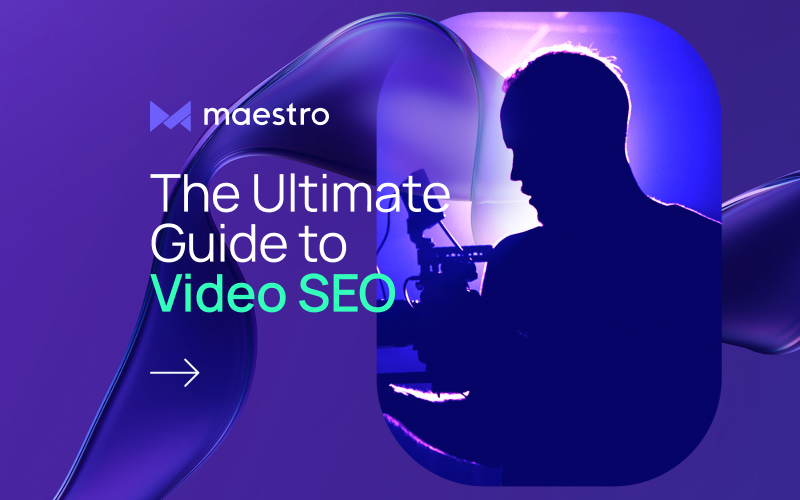The Ultimate Guide to Video SEO

Getting their video content in front of more viewers is the goal of many brands and creators. One easy way to accomplish this is with video SEO. By optimizing your videos for SEO, you can improve your ranking in search engines and improve traffic to your content.
In this article, we’ll cover everything you need to know about video SEO. We’ll discuss what it is and what you need to do to implement it in your marketing strategy. To wrap things up, we’ll cover what video SEO tools are offered by Maestro.
What is Video SEO?
Video search engine optimization (SEO) is a video distribution technique that taps into organic search traffic for relevant terms to get your video content discovered by your target audience.
The goal of video SEO is to increase the visibility of your video content, whether that be free video content or landing pages for events.
If you’re familiar with SEO for blog posts or landing pages, a lot of the same principles apply. You want to create high-quality content that is optimized for the target keywords.
Why is Video SEO Important?
Video SEO has many benefits for brands and creators. The most significant benefit is that it increases the visibility of your content, whether that be free video content or landing pages for events.
With increased visibility comes greater brand awareness. This is great for reaching a more significant part of your target audience.
By increasing your organic traffic and improving your rankings, you’ll get in front of people who are in need of whatever solution you have to offer. This can help improve your click-through rates and increase your conversions, which is another win-win.
How to Optimize Your Videos for SEO
Now that you know more about the benefits of leveraging SEO to distribute your video content, let’s get into the actionable steps you can take to optimize your videos for SEO.
1. Conduct Keyword Research

The first step to optimizing your videos for SEO is choosing keywords to target. You’ll want to look for keywords that have an appropriate level of search volume and relevant intent.
Some of our favorite tools for keyword research include Keywords Everywhere and SpyFu. Each of these tools provides valuable keyword data, such as search volumes, competition, and CPC.
If you need help with topic ideation, explore the People Also Ask section of the SERPs for keywords that are most relevant to your brand or content. Quora and Reddit are also great for finding user-generated inquiries.
Exploring the video libraries and blogs of other brands and creators in your niche should provide some inspiration, as well. With that said, be sure not to plagiarize or blatantly steal content from others. Choose topics that you can provide a valuable or unique twist on.
2. Create Valuable Content
The next step is to create valuable content. Search engines favor content that provides value to consumers, so if you want your videos to rank, you need to make sure that they are valuable to viewers.
Creating valuable video content starts with an actionable plan. As you come up with topics for videos, you should map out exactly what you want people to take away from your content. You can outline everything you’d like to cover in a video so you know what you can speak to and what you need to supplement with additional resources or assets.
On this note, it’s essential to avoid creating content that is full of fluff. Publishing videos just for the sake of getting something out there is useless. Focus on creating content that has a real purpose.
3. Optimize Video Titles, Descriptions, and Tags
Another crucial component of video SEO is optimizing the metadata that search engines crawl. This includes titles, descriptions, and tags. You should optimize this data to include your target and secondary keywords.
Please remember to avoid keyword stuffing. You should incorporate keywords in a way that flows naturally. Including keywords in a way that reads awkwardly will crush the user experience and will not help your SEO efforts.
4. Add Transcripts and Closed Captions

Including transcripts and closed captions for your videos has a few benefits.
For starters, it is easier for search engines to understand the contents of text than it is to understand a video, so any additional context you can provide is valuable. By including transcripts and closed captions, the search engines have access to that additional context.
Additionally, transcripts and closed captions improve the user experience since they make the content accessible to those who are hard of hearing. It’s also useful for those who are unable to listen to audio when they need to access the information.
Best Practices for Video SEO
In addition to the actionable tips for optimizing your videos for SEO, we’ve rounded up a few best practices for video SEO. Here’s what we’ve got.
Use High-Quality Video and Audio
As we mentioned, search engines tend to prioritize high-quality content. In addition to the messaging and information in the video, it’s important to ensure that the quality of the video and audio is pristine.
Subpar video and audio quality can hurt the user experience, which could cause users to close out your site. This will hurt your SEO.
Use an Online Video Platform
One way to improve your SEO is by using an online video platform like Maestro that includes video SEO tools. You need a platform that allows you to edit the metadata that search engines crawl.
By choosing a reliable online video platform, you can also ensure that your site loads bulky files efficiently so your site performance is optimal.
Monitor Your Metrics
An important part of success with SEO is to assess what’s working and what’s not so you can pivot accordingly.
If you notice that a specific topic tends to perform better than others, lean into that. If certain types of videos garner more viewers, make those a priority. Observe the lengths and styles that perform well to use that as a blueprint for future content.
Update Your Video Content Regularly
One way to keep your video content ranking at the top of the SERPs is to update your content regularly. Keeping things timely and accurate will ensure that your content remains relevant and valuable to your viewers, which is of utmost importance.
On the same note, it’s important to produce content consistently to help your SEO efforts grow. Quality should remain a priority, but creating more content will increase your odds of ranking it in coveted positions.
Video SEO on Maestro
Maestro offers some new and improved video SEO features that help users improve the discoverability of their content. With our platform, you can optimize your video metadata and rest assured that your site is optimized for the best user experience possible.
Sign up today to explore our video SEO tools.
Join our Discord server to learn more tips and tricks for streaming on Maestro.